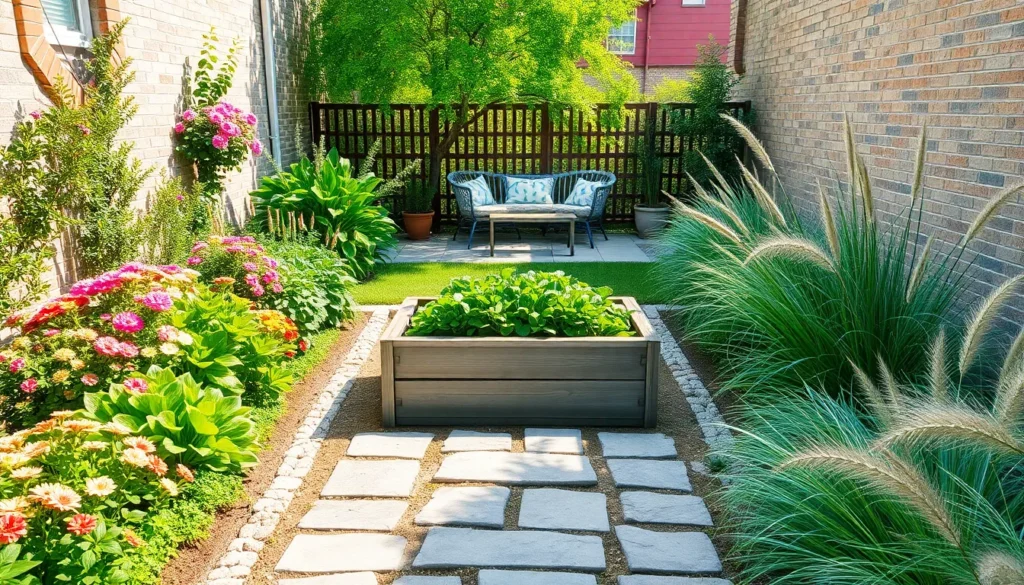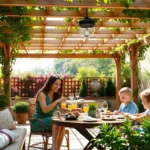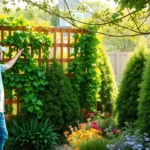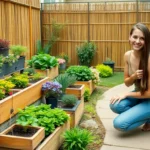Rectangular gardens offer endless possibilities for creating stunning outdoor spaces that maximize every square foot. Whether you’re working with a narrow side yard or a spacious backyard plot, we’ll show you how to transform your rectangular space into a garden paradise that’s both functional and beautiful.
Most homeowners think rectangular gardens are limiting, but we’ve discovered they’re actually the most versatile shape to work with. From formal geometric designs to flowing cottage-style layouts, rectangular spaces provide the perfect framework for organizing plants, pathways, and focal points that create visual impact.
We’ve compiled proven design strategies that’ll help you make the most of your rectangular garden’s unique proportions. You’ll discover how to create depth, add visual interest, and maximize growing space while maintaining a cohesive look that enhances your home’s curb appeal.
Create Defined Zones for Different Garden Functions
Strategic zoning transforms rectangular gardens into purposeful outdoor spaces that serve multiple needs. We’ll show you how to divide your garden into distinct areas that maximize both beauty and functionality.
Designate a Vegetable Growing Area
Position your vegetable zone in the sunniest corner of your rectangular garden to ensure optimal growing conditions. Most vegetables like tomatoes, peppers, and squash need 6-8 hours of direct sunlight daily for healthy development.
Create raised beds or container gardens to define this productive space clearly. Raised beds measuring 4 feet wide by 8 feet long work perfectly in rectangular layouts, allowing easy access from both sides while maximizing growing space.
Install drip irrigation or soaker hoses along your vegetable rows to maintain consistent moisture levels. This watering system keeps plants healthy while reducing water waste and preventing disease issues common with overhead watering.
Add a small tool storage shed or cabinet near your vegetable area for convenient access to gardening supplies. Storage answers like weatherproof deck boxes or slim garden sheds keep tools organized and protect them from the elements.
Establish a Flower Display Section
Design flower borders along the longest edges of your rectangular garden to create maximum visual impact. Long borders allow you to plant in layers, with tall plants like hollyhocks and delphiniums in the back, medium plants like roses and peonies in the middle, and low plants like marigolds and alyssum in front.
Choose a color scheme that complements your home’s exterior to create visual harmony between your garden and architecture. Warm colors like reds, oranges, and yellows create energy, while cool blues, purples, and whites provide calming elegance.
Plant seasonal flowers in dedicated sections to ensure continuous blooms throughout the growing season. Spring bulbs like tulips and daffodils, summer annuals like petunias and impatiens, and fall perennials like chrysanthemums and asters provide year round interest.
Incorporate focal points like ornamental trees or large shrubs at key locations within your flower display. Japanese maples, flowering dogwoods, or large hydrangeas create structure and anchor your flower arrangements with permanent features.
Include a Relaxation and Seating Zone
Position your seating area in a corner or along one side of your rectangular garden to create an intimate retreat space. Corner locations provide natural privacy screens using garden borders or fencing as backdrop elements.
Choose furniture that matches your garden’s scale and style to maintain design consistency throughout the space. Small bistro sets work well in compact rectangles, while larger dining sets or sectional seating suits bigger rectangular areas.
Create natural shade using pergolas, umbrellas, or strategically planted trees to make your seating zone comfortable during hot summer days. Pergolas covered with climbing vines like clematis or grape vines provide both shade and visual interest overhead.
Add outdoor lighting like string lights, solar path lights, or lanterns to extend the usability of your relaxation zone into evening hours. Soft lighting creates ambiance and allows you to enjoy your rectangular garden space after sunset.
Design Structured Pathways to Maximize Space

We’ll transform your rectangular garden’s functionality by creating well-planned pathways that enhance both accessibility and visual appeal.
Install a Central Walkway for Easy Access
Central walkways provide the backbone of effective rectangular garden design. Installing a main pathway down the center or length of your garden creates natural symmetry while ensuring easy access to all areas. Stone materials offer durability and classic appeal, while brick provides warmth and traditional charm. Wood pathways blend naturally with planted areas and soften the overall aesthetic.
Positioning your central walkway strategically maximizes the garden’s potential. We recommend placing it to connect your home’s entrance with the garden’s focal point or back boundary. This approach creates a sense of purpose and draws visitors through the entire space. Materials should complement your home’s architecture and existing hardscaping elements.
Create Perpendicular Side Paths for Organization
Perpendicular pathways branching from your central walkway maximize space utilization. These secondary paths should lead to exact garden zones like vegetable beds, seating areas, or decorative features. Organizing your garden with this grid-like system helps visitors navigate efficiently while creating distinct sections for different purposes.
Side paths work best when they’re narrower than your main walkway. We suggest making perpendicular paths 2-3 feet wide compared to a 4-5 foot central walkway. This proportional difference maintains visual hierarchy while ensuring adequate access. Consider using the same materials as your central path for continuity or complementary materials for subtle variation.
Use Stepping Stones for Informal Navigation
Stepping stones create natural flow between planted areas without formal pathway commitment. These informal navigation elements blend seamlessly into your garden’s industry while providing access to maintenance areas or special features. Natural stone options integrate beautifully with surrounding plants and soil.
Strategic placement of stepping stones enhances your garden’s organic feel. We recommend spacing them 18-24 inches apart for comfortable walking while allowing plants to grow between and around them. This technique works particularly well for connecting formal pathways to secluded seating areas or leading visitors through flower borders without disturbing the planted design.
Implement Vertical Growing Solutions

Maximizing our rectangular garden’s potential means thinking beyond ground level. Vertical growing answers transform empty walls and fences into productive growing space while softening harsh rectangular lines.
Install Trellises Along the Perimeter
Trellises create stunning perimeter boundaries that support climbing plants and vines throughout our rectangular garden space. We can position these structures along existing fences or walls to break up straight lines visually while providing essential plant support.
Material Options for Garden Trellises:
| Material | Durability | Maintenance | Best For |
|---|---|---|---|
| Cedar Wood | 10-15 years | Low | Natural aesthetic gardens |
| Metal Wire | 15-20 years | Very Low | Modern, minimalist designs |
| Bamboo | 5-8 years | Medium | Eco-friendly, cottage styles |
| Vinyl | 20+ years | Very Low | Contemporary, low-maintenance spaces |
Installing trellises along our garden’s longest edges provides maximum coverage for climbing vegetables like beans, peas, and cucumbers. We can also train flowering vines such as clematis, morning glories, or jasmine to create beautiful seasonal displays.
Add Wall-Mounted Planters for Small Spaces
Wall-mounted planters maximize our growing capacity without consuming valuable floor space in compact rectangular gardens. These versatile containers attach directly to fences, walls, or existing structures to create instant vertical gardens.
Benefits of Wall-Mounted Growing Systems:
- Space Efficiency: We can grow herbs, lettuce, and strawberries vertically without reducing ground-level planting areas
- Easy Access: Mounting planters at comfortable heights eliminates bending and kneeling during harvest
- Improved Drainage: Elevated positioning prevents waterlogging issues common in ground-level containers
- Design Flexibility: We can arrange multiple planters in patterns that complement our garden’s aesthetic
Positioning wall-mounted planters on south-facing surfaces ensures optimal sun exposure for most vegetables and herbs. We recommend using planters with built-in water reservoirs to reduce maintenance frequency and ensure consistent plant hydration.
Incorporate Climbing Structures for Vines
Climbing structures add architectural interest while supporting productive vine growth throughout our rectangular garden design. We can integrate these features into existing boundaries or create standalone focal points that break up monotonous sight lines.
Popular Climbing Structure Options:
Living walls effectively cover large fence sections while providing growing space for herbs, vegetables, and ornamental plants. We can install modular pocket systems or create custom wooden frameworks with planting compartments.
Arbors and pergolas create stunning entrance points or transition zones within our rectangular layout. These structures support heavy vines like grapes, wisteria, or climbing roses while providing partial shade for seating areas below.
Obelisks and pyramid structures serve as vertical focal points in planting beds while supporting annual vines such as sweet peas or pole beans. We can position these throughout our garden to create rhythm and visual balance.
Wire and cable systems offer minimalist support for lightweight climbers without overwhelming our garden’s design. These nearly invisible structures allow plants to become the primary visual element while maintaining clean, modern aesthetics.
Establish Focal Points Using Geometric Patterns

Breaking away from traditional linear designs transforms rectangular gardens into visually ever-changing spaces. Geometric patterns create compelling visual anchors that draw attention and add sophisticated structure to your outdoor space.
Create Symmetrical Planting Beds
Mirror image planting establishes harmony by designing identical planting beds on either side of a central pathway. We recommend selecting plants with similar heights, colors, and textures to maintain perfect balance throughout the growing season.
Balanced borders work best when you choose complementary plant combinations that bloom at different times. Consider pairing spring bulbs with summer perennials and fall chrysanthemums to ensure continuous visual interest.
Identical garden features enhance the symmetrical effect by placing matching benches, planters, or decorative elements on each side. This approach creates a formal garden atmosphere while maintaining the rectangular space’s natural flow.
Design Diamond or Square Raised Sections
Textured raised elements add depth and visual variety by incorporating different materials like cedar wood, natural stone, or composite lumber. These elevated sections create natural boundaries while providing improved drainage for your plants.
Multilevel planting areas maximize growing space by establishing varying heights throughout your rectangular garden. We suggest creating 6 to 12 inch raised sections for herbs and vegetables, with taller 18 to 24 inch sections for deeper rooted plants.
Geometric raised beds work particularly well when designed as diamond or square shapes positioned at strategic points. This configuration breaks up the rectangular monotony while creating organized growing zones for different plant categories.
Install a Central Feature Like a Fountain or Statue
Water features serve as stunning focal points that draw the eye away from the garden’s rectangular boundaries. A central fountain or small pond creates soothing ambient sounds while providing a natural gathering spot for wildlife.
Sculptural elements add artistic interest when positioned as the garden’s centerpiece. We recommend choosing statues or sculptures that complement your home’s architectural style and match the scale of your rectangular space.
Architectural focal points work best when they’re proportionate to the garden size and create visual balance. Consider pergolas, obelisks, or decorative arbors that provide both structural interest and support for climbing plants.
Build Raised Beds for Better Organization
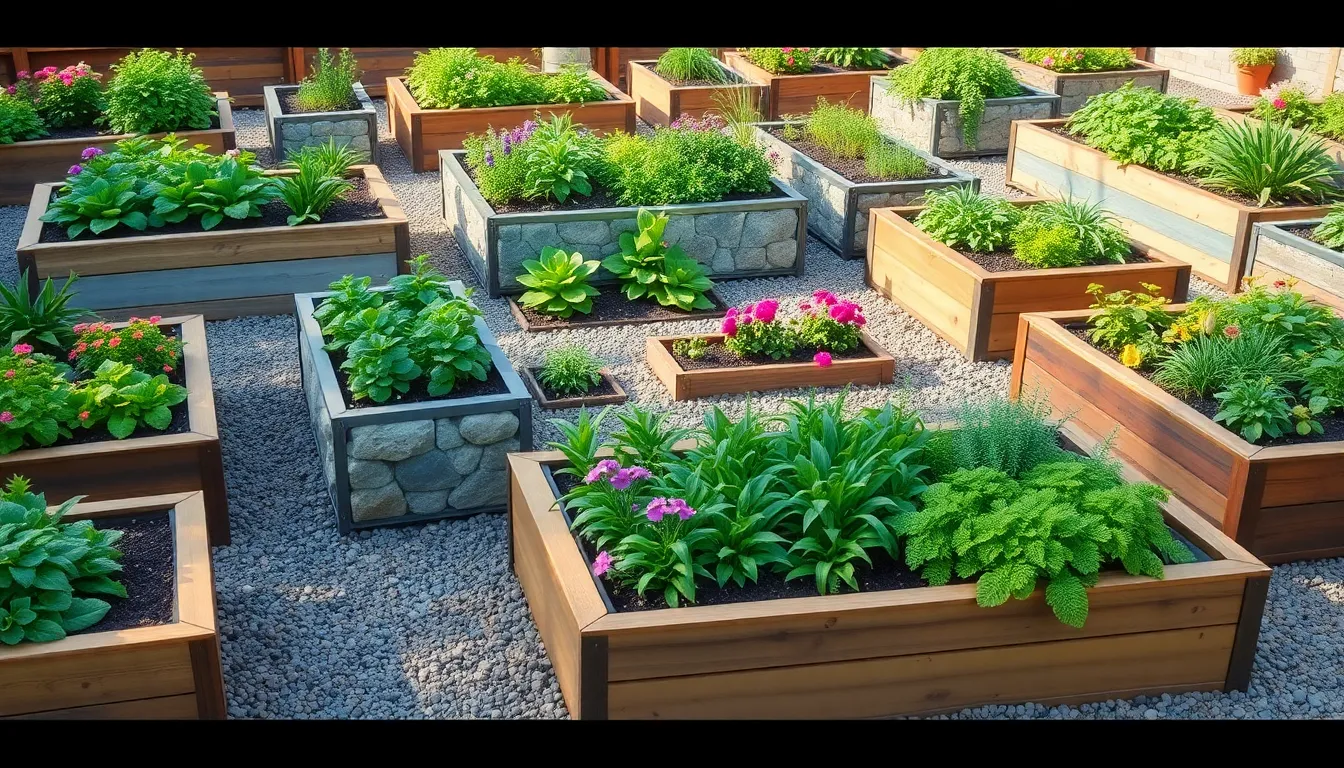
Raised beds transform rectangular gardens into organized, productive spaces that deliver exceptional results. We’ll explore three strategic approaches that maximize your garden’s potential while creating stunning visual appeal.
Construct Parallel Rectangular Planters
Parallel rectangular planters create clean lines that complement your garden’s natural shape while improving visual appeal. We recommend positioning these planters to run lengthwise along your garden’s longest dimension, creating natural corridors for easy maintenance access.
Wood planters offer warmth and blend seamlessly with natural landscapes, lasting 5-10 years with proper treatment. Metal containers provide modern aesthetics and exceptional drainage, perfect for contemporary garden designs. Plastic options deliver lightweight convenience and weather resistance at budget-friendly prices.
Space your parallel planters 3-4 feet apart to allow comfortable walking paths between sections. This spacing ensures you can easily tend to plants from both sides while maintaining proper air circulation throughout your garden.
Create Tiered Levels for Visual Interest
Tiered levels add remarkable depth to rectangular gardens by breaking up flat surfaces and creating ever-changing visual layers. We suggest building multiple raised beds at varying heights to achieve this layered effect that draws the eye through your garden space.
Low tier beds (8-12 inches high) work perfectly for ground-covering plants and herbs that spread naturally. Medium height sections (16-20 inches) accommodate most vegetables and flowering plants while providing comfortable access. Tall tier areas (24-30 inches) create dramatic focal points and support larger plants or small trees.
Position your tallest beds toward the back or center of your garden to avoid shading shorter plants. This arrangement creates natural depth while ensuring all plants receive adequate sunlight throughout the growing season.
Use Different Materials for Varied Textures
Different materials throughout your raised bed system create visual interest and define distinct garden zones effectively. We recommend combining complementary materials that enhance your garden’s overall aesthetic while serving practical purposes.
Stone walls provide permanent structure and natural beauty, improving drainage while lasting decades with minimal maintenance. Gravel pathways offer excellent drainage between beds and create clean separation lines. Wood edging adds warmth and flexibility, allowing easy modification as your garden evolves.
Metal accents introduce modern elements and reflect light, brightening darker garden areas. Combine rough stone textures with smooth metal surfaces to create compelling contrast that keeps visitors engaged as they move through your organized garden space.
Incorporate Border Plantings for Definition

Border plantings create clear structure and visual boundaries that transform a simple rectangular garden into defined outdoor rooms. These strategic plantings help organize different functional areas while adding layers of color, texture, and seasonal interest throughout the year.
Plant Hedges Along the Rectangle’s Edges
Hedges serve as living walls that frame your rectangular garden while providing natural privacy screening. We recommend selecting hedge varieties that suit your local climate and maintenance preferences, such as boxwood for formal designs or privet for faster growth. Position these plantings along the perimeter to soften harsh rectangular lines and create an enclosed, intimate garden atmosphere.
Dense hedge rows also act as windbreaks, protecting more delicate plants in your garden’s interior zones. Choose evergreen species like yew or holly for year-round structure, or deciduous options like hornbeam for seasonal color changes. Space individual hedge plants according to their mature width to ensure proper coverage without overcrowding.
Use Ornamental Grasses for Natural Boundaries
Ornamental grasses bring movement and texture that creates subtle divisions between different garden areas. We suggest planting varieties like fountain grass, miscanthus, or feather reed grass to establish flowing boundaries that feel organic rather than rigid. These grasses add vertical interest while maintaining visual permeability between garden zones.
Seasonal changes in ornamental grasses provide year-round appeal, from fresh spring growth to golden autumn colors and winter seed heads. Plant them in drifts or linear arrangements to guide the eye along desired pathways. Their natural swaying motion adds ever-changing energy that contrasts beautifully with more structured plantings elsewhere in your rectangular space.
Install Decorative Edging Materials
Decorative edging materials provide permanent definition that separates planted areas from pathways, lawns, or mulched zones. We recommend materials like natural stone, brick, or composite lumber that complement your home’s architectural style and existing hardscape elements. These edging answers create clean lines that enhance the organized appearance of your rectangular garden layout.
Install edging at consistent heights and angles to maintain visual continuity throughout different garden sections. Metal edging offers sleek, modern appeal while being nearly invisible, allowing plants to take center stage. Wood edging provides rustic charm and can be easily customized to follow curved or angular design elements within your rectangular framework.
Add Seasonal Interest Through Strategic Planting

Strategic planting transforms rectangular gardens into ever-changing spaces that captivate throughout every season. We’ll create continuous visual appeal by combining plants that bloom at different times and provide structural elements for year-round beauty.
Plan for Four-Season Color Rotation
Four-season color rotation ensures our rectangular garden maintains vibrancy throughout the entire year. We start with spring bulbs like tulips and daffodils that emerge first, creating early color along our garden’s borders. Summer follows with bright annuals and daisies that fill the warmer months with bold hues and attract beneficial pollinators.
Autumn brings chrysanthemums and ornamental grasses that provide rich textures and warm colors as temperatures cool. Winter interest comes from plants like holly or euphorbia that offer berries, unique foliage, and architectural forms during dormant months. This strategic rotation prevents our garden from experiencing dull periods and maintains visual excitement across all seasons.
Planning color rotation involves mapping bloom times on paper before planting. We position early bloomers near pathways for immediate spring impact, place summer flowers in central viewing areas, and cluster autumn plants where they’ll catch afternoon light. Winter elements work best as backdrop plants that provide structure when other plants fade.
Include Evergreen Elements for Year-Round Structure
Evergreen elements provide constant greenery and architectural shape that anchor our rectangular garden design. We incorporate evergreen shrubs and hedges to create permanent structure that remains attractive during winter months when deciduous plants lose their leaves. These plants serve as backdrops for seasonal displays and maintain privacy throughout the year.
Living walls with evergreen plants soften harsh fence and wall edges in narrow rectangular spaces while providing vertical growing opportunities. Climbing evergreens like ivy or winter jasmine transform vertical surfaces into green features that add depth and dimension. We can also use evergreen topiaries or shaped shrubs to create formal elements that complement our garden’s geometric lines.
Evergreen placement requires considering mature sizes and growth patterns. We position larger evergreens at corners or boundaries to frame views, use medium-sized varieties for mid-garden structure, and incorporate smaller evergreens as accent plants. This layered approach creates visual depth while ensuring year-round appeal.
Design Succession Planting Areas
Succession planting areas ensure continuous interest by timing different plants to peak as others fade. We layer plants with staggered blooming times so spring bulbs give way to summer perennials, which transition to autumn displays. This approach maximizes our rectangular garden’s visual impact throughout growing seasons.
Self-seeding plants extend interest naturally and provide habitat for wildlife while reducing maintenance needs. We incorporate plants with long-lasting seed heads like echinacea or rudbeckia that offer winter structure and bird food. These plants create natural succession while adding texture and movement to our garden design.
Rectangular garden corners become ideal spots for succession planting around seating areas or focal points. We create layered plantings that welcome visitors with changing displays throughout the year. Corners also work well for succession vegetable gardens where we plant cool-season crops followed by warm-season varieties, maximizing harvest potential in our rectangular space.
Integrate Practical Features for Garden Maintenance

We can transform our rectangular garden into a low maintenance powerhouse by incorporating smart features that make upkeep effortless and efficient.
Install Irrigation Systems Along Straight Lines
Straight line irrigation systems work perfectly in rectangular gardens because they follow the natural geometry of the space. We can install drip irrigation lines parallel to our garden borders, ensuring every plant receives consistent water distribution without waste.
Modern irrigation systems benefit from the linear layout by reducing the number of turns and connections needed. This setup minimizes pressure loss and creates uniform moisture levels throughout our entire garden space.
Timer controlled systems maximize efficiency when installed along straight pathways between our planted zones. We’ll save time on daily watering while maintaining optimal soil moisture for healthier plant growth.
Create Storage Answers in Corner Spaces
Corner storage units transform unused spaces into functional areas for our gardening tools and supplies. We can install weatherproof cabinets or build custom storage benches that blend seamlessly with our garden’s rectangular design.
Vertical storage towers work exceptionally well in corners where they won’t interfere with plant growth or pathway access. These answers keep our garden organized while storing everything from hand tools to fertilizers within easy reach.
Hidden storage compartments built into raised bed corners provide discrete spaces for smaller items like seeds, labels, and pruning shears. This approach maintains our garden’s clean aesthetic while keeping essential supplies close to where we need them most.
Design Composting Areas Within the Layout
Composting systems integrated into rectangular gardens create sustainable waste management while producing nutrient rich soil for our plants. We can position compost bins in discrete corners or behind screening plants to maintain visual appeal.
Three bin composting systems fit naturally along one edge of rectangular spaces, allowing us to rotate materials through different stages of decomposition. This method produces consistent compost while keeping our garden waste cycle organized and efficient.
Screened composting areas using lattice panels or tall plants help maintain our garden’s polished appearance while processing organic matter. We’ll create rich soil amendments right where we need them most, reducing the need to purchase commercial fertilizers.
Maximize Small Rectangular Spaces

Small rectangular gardens present unique opportunities when we apply targeted design strategies. We can transform these seemingly limiting spaces into vibrant, functional outdoor areas that feel surprisingly spacious.
Use Container Gardening for Flexibility
Container gardening offers unmatched versatility for small rectangular gardens. We can move containers around to optimize sunlight exposure and adjust our design aesthetics as seasons change. This flexibility allows us to experiment with different layouts until we find the perfect configuration.
Grouping containers of varying heights creates natural dimension in narrow spaces. We recommend mixing tall planters with medium and low containers to establish visual layers. Corner areas become productive growing zones when we position container clusters strategically.
Seasonal plant changes become effortless with container systems. We can swap out summer annuals for autumn displays without disturbing established garden beds. Different colored containers help break up the rigid lines of rectangular spaces while adding personality to our outdoor design.
Carry out Square Foot Gardening Methods
Square foot gardening maximizes productivity in small rectangular spaces through organized bed divisions. We divide our garden beds into manageable one foot squares, allowing for higher planting density and easier maintenance access.
This method reduces weed growth significantly compared to traditional row planting. We can grow more vegetables, herbs, and flowers in less space while maintaining clear organization. Each square receives dedicated attention, resulting in healthier plants and better yields.
Rectangular beds work perfectly with square foot methodology since we can create neat grids. We recommend using string or thin wood strips to mark individual squares within raised planters. This systematic approach fits naturally within rectangular garden boundaries while maximizing every inch of growing space.
Create Illusions of Depth Through Plant Placement
Strategic plant placement transforms narrow rectangular gardens into spaces that feel wider and deeper. We position taller plants toward the back or center areas, then gradually decrease height toward the front edges. This layering technique draws the eye through multiple levels of interest.
Varying plant textures adds visual complexity that expands perceived space. We combine fine textured grasses with broad leafed hostas and spiky architectural plants. These contrasts create focal points that prevent the eye from immediately recognizing rectangular boundaries.
Curved planting lines within rectangular layouts soften harsh edges effectively. We plant in gentle arcs rather than straight rows, even within geometric bed shapes. Vertical elements like trellises and tall ornamental grasses add upward dimension, making our garden feel more expansive than its actual footprint suggests.
Conclusion
Rectangular gardens offer endless possibilities when we embrace strategic design principles and creative thinking. By implementing zones raised beds vertical elements and seasonal plantings we can transform these spaces into ever-changing outdoor sanctuaries that rival any garden shape.
The key lies in breaking away from rigid thinking and using the rectangle’s natural structure to our advantage. Whether we’re working with expansive yards or compact urban spaces these proven techniques help us maximize both beauty and functionality.
With proper planning our rectangular gardens become year-round destinations that provide fresh produce stunning displays and peaceful retreats. The geometric foundation we start with becomes the perfect canvas for expressing our personal gardening vision while maintaining organized efficient growing spaces.
Frequently Asked Questions
What are the main advantages of rectangular garden layouts?
Rectangular gardens offer exceptional versatility and can accommodate various design styles from formal to cottage-like layouts. They provide excellent opportunities for creating defined zones, structured pathways, and organized growing spaces. The straight lines make it easier to install irrigation systems, create symmetrical designs, and maximize growing space efficiently.
How can I create different zones in my rectangular garden?
Divide your rectangular garden into three main zones: a vegetable growing area in the sunniest corner with raised beds, a flower display section along the longest edges with layered plantings, and a relaxation zone with comfortable seating. Use pathways, raised beds, or different materials to clearly define each functional area.
What’s the best way to add vertical growing space to a rectangular garden?
Install trellises along the perimeter to support climbing plants and soften harsh lines. Use wall-mounted planters for compact spaces and incorporate climbing structures like arbors or obelisks. These vertical elements maximize growing space while adding architectural interest and helping to break up the rectangular boundaries.
How do I make my rectangular garden look less boxy?
Create focal points using geometric patterns, add curved planting lines to soften edges, and incorporate varied heights through tiered raised beds. Use stepping stones for informal navigation, plant ornamental grasses for movement, and establish a central feature like a fountain or statue to draw attention away from straight boundaries.
What’s the most efficient pathway design for rectangular gardens?
Install a central walkway to create symmetry and ensure easy access throughout the garden. Add perpendicular side paths to organize the space into distinct zones. Use materials like stone, brick, or wood that complement your garden’s aesthetic, and consider stepping stones for informal navigation between planted areas.
How can I ensure year-round interest in my rectangular garden?
Implement a four-season color rotation: spring bulbs, summer annuals, autumn chrysanthemums, and winter evergreens. Include evergreen elements for structure and use succession planting areas with staggered blooming times. Incorporate self-seeding varieties and layer plants that bloom at different periods to maintain continuous visual appeal.
What are the best materials for raised beds in rectangular gardens?
Wood, metal, and plastic are excellent choices for raised beds, each offering different aesthetic and practical benefits. Combine varied materials like stone, wood, and metal to create distinct zones and enhance visual interest. Consider the durability, cost, and how well each material complements your overall garden design.
How do I maximize space in a small rectangular garden?
Use container gardening for flexibility and easy rearrangement. Implement square foot gardening methods to organize bed divisions efficiently. Group containers of varying heights to create visual layers, place taller plants at the back, and use vertical elements to add dimension and make the space feel larger.

